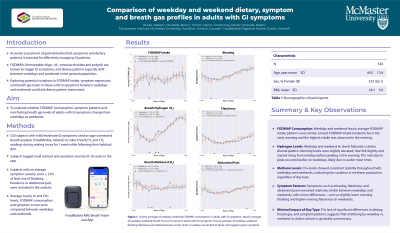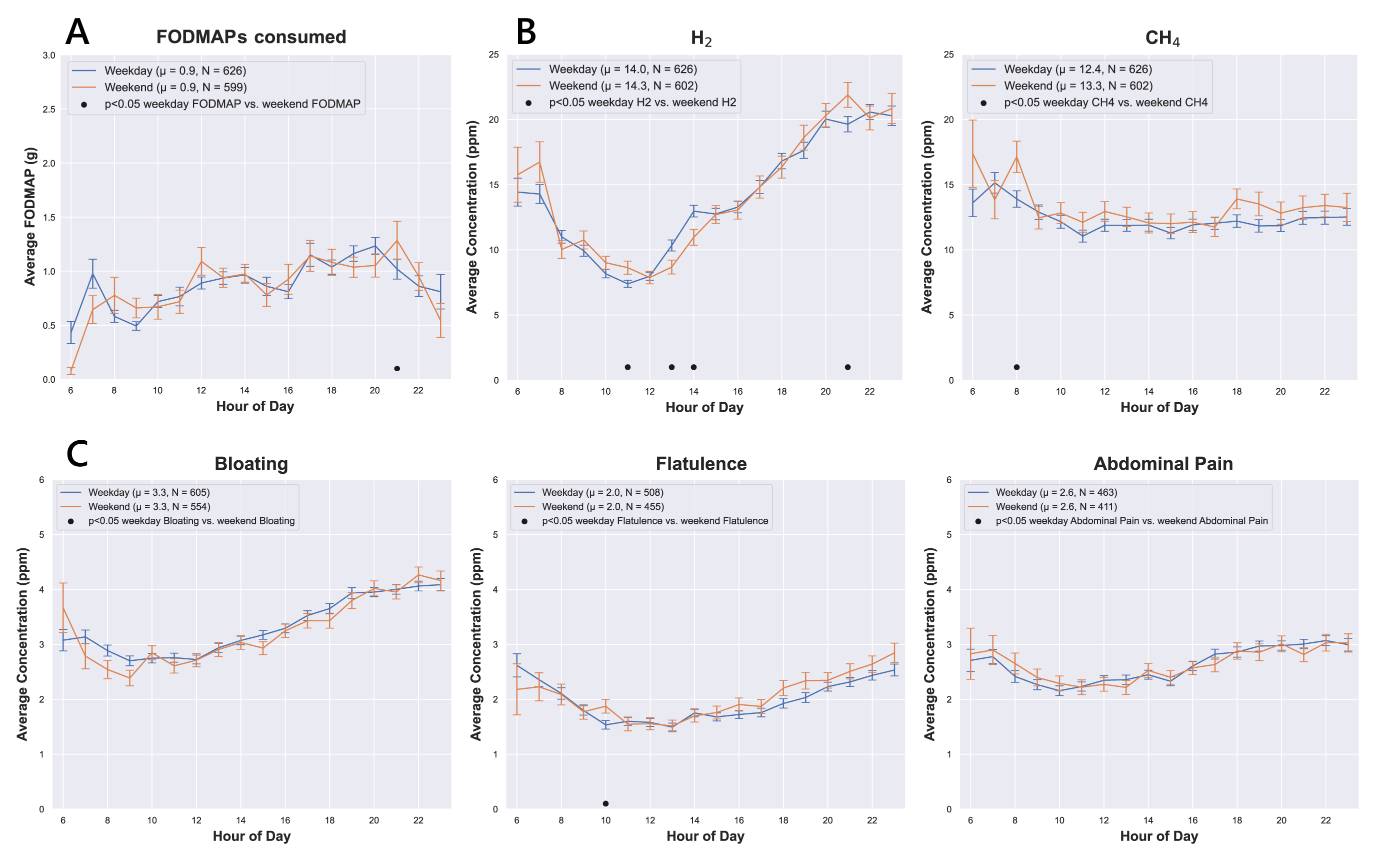Tuesday Poster Session
Category: Functional Bowel Disease
P4071 - Comparison of Weekday and Weekend Dietary, Symptom, and Breath Gas Profiles in Adults With GI Symptoms
Tuesday, October 29, 2024
10:30 AM - 4:00 PM ET
Location: Exhibit Hall E


David Armstrong, MA, MBBCh
McMaster University
Hamilton, ON, Canada
Presenting Author(s)
David Armstrong, MA, MBBCh1, Barry McBride, MSc2, Robert Burke, MSc3, Pedro Miranda, PhD1, Claire Shortt, PhD4
1McMaster University, Hamilton, ON, Canada; 2FoodMarble Digestive Health Ltd., Dublin, Dublin, Ireland; 3FoodMarble Digestive Health Ltd., Tipperary, Tipperary, Ireland; 4FoodMarble, Dublin, Dublin, Ireland
Introduction: Accurate assessment of gastrointestinal (GI) symptoms and dietary patterns is essential for effectively managing GI patients. In the general population, dietary patterns typically change from weekdays to weekends. FODMAPs (fermentable oligo-, di-, monosaccharides and polyols) are food components that are known to trigger GI symptoms. In this retrospective study of adults with GI symptoms, we evaluated whether FODMAP consumption, symptom patterns and non-fasting breath gas levels changed from weekdays to weekends.
Methods: Subjects with mild/moderate GI symptoms used an app-connected breath analyzer (FoodMarble, Ireland) to collect hourly H2 and CH4 readings during waking hours and logged meal content and symptom severity (0-10 scale) while following their habitual diet for 1 week. Subjects with an average symptom severity ≥ 3 for at least one of bloating, flatulence or abdominal were included in the analysis. Average hourly H2 and CH4 levels, FODMAP consumption and symptom scores were compared between weekdays and weekends.
Results: 626 subjects (383 women, mean age 44 ± 13) were included in the analysis. There were no significant weekday-weekend differences in hourly average FODMAP consumption (Figure 1A), although there was an early rise in weekday consumption, possibly reflecting earlier breakfast times. Weekend morning H2 was slightly higher than weekday H2, which may reflect increased fermentable intake on the evenings previous or later evening meal timings on the weekend (Figure 1B). The typical rise in diurnal H2 seen in the middle of the day happens sooner on weekdays. Possibly due to earlier morning and midday meal times. Weekday-weekend CH4 levels were more stable throughout the day. The symptoms are relatively similar between the weekend and weekday. For the weekend, bloating is generally somewhat lower, flatulence somewhat higher, especially for the latter half of the day and abdominal pain slightly elevated in the morning (Figure 1C).
Discussion: Despite some points of difference, overall dietary, breath gas and symptom patterns do not appear to vary greatly between weekdays and weekends in this cohort. This indicates that there would typically not be a need to stratify by weekend and weekday in analyses of these variables in similar cohorts. Where breath samples are to be collected at particular time points in the day, the timing could be set to where the weekend and weekday levels are most similar and least changeable on average.

Disclosures:
David Armstrong, MA, MBBCh1, Barry McBride, MSc2, Robert Burke, MSc3, Pedro Miranda, PhD1, Claire Shortt, PhD4. P4071 - Comparison of Weekday and Weekend Dietary, Symptom, and Breath Gas Profiles in Adults With GI Symptoms, ACG 2024 Annual Scientific Meeting Abstracts. Philadelphia, PA: American College of Gastroenterology.
1McMaster University, Hamilton, ON, Canada; 2FoodMarble Digestive Health Ltd., Dublin, Dublin, Ireland; 3FoodMarble Digestive Health Ltd., Tipperary, Tipperary, Ireland; 4FoodMarble, Dublin, Dublin, Ireland
Introduction: Accurate assessment of gastrointestinal (GI) symptoms and dietary patterns is essential for effectively managing GI patients. In the general population, dietary patterns typically change from weekdays to weekends. FODMAPs (fermentable oligo-, di-, monosaccharides and polyols) are food components that are known to trigger GI symptoms. In this retrospective study of adults with GI symptoms, we evaluated whether FODMAP consumption, symptom patterns and non-fasting breath gas levels changed from weekdays to weekends.
Methods: Subjects with mild/moderate GI symptoms used an app-connected breath analyzer (FoodMarble, Ireland) to collect hourly H2 and CH4 readings during waking hours and logged meal content and symptom severity (0-10 scale) while following their habitual diet for 1 week. Subjects with an average symptom severity ≥ 3 for at least one of bloating, flatulence or abdominal were included in the analysis. Average hourly H2 and CH4 levels, FODMAP consumption and symptom scores were compared between weekdays and weekends.
Results: 626 subjects (383 women, mean age 44 ± 13) were included in the analysis. There were no significant weekday-weekend differences in hourly average FODMAP consumption (Figure 1A), although there was an early rise in weekday consumption, possibly reflecting earlier breakfast times. Weekend morning H2 was slightly higher than weekday H2, which may reflect increased fermentable intake on the evenings previous or later evening meal timings on the weekend (Figure 1B). The typical rise in diurnal H2 seen in the middle of the day happens sooner on weekdays. Possibly due to earlier morning and midday meal times. Weekday-weekend CH4 levels were more stable throughout the day. The symptoms are relatively similar between the weekend and weekday. For the weekend, bloating is generally somewhat lower, flatulence somewhat higher, especially for the latter half of the day and abdominal pain slightly elevated in the morning (Figure 1C).
Discussion: Despite some points of difference, overall dietary, breath gas and symptom patterns do not appear to vary greatly between weekdays and weekends in this cohort. This indicates that there would typically not be a need to stratify by weekend and weekday in analyses of these variables in similar cohorts. Where breath samples are to be collected at particular time points in the day, the timing could be set to where the weekend and weekday levels are most similar and least changeable on average.

Figure: Figure 1. (A) Hourly averages of weekday-weekend FODMAP consumption in adults with GI symptoms. (B) Hourly averages of weekday-weekend breath H2 and CH4 levels in adults with GI symptoms. (C) Hourly averages of weekday-weekend bloating, flatulence and abdominal pain scores. Note: n numbers are limited to those who logged a given symptom.
Disclosures:
David Armstrong: AI VALI Inc – Owner/Ownership Interest. Amgen – Speakers Bureau. Cinclus Pharma – Advisor or Review Panel Member. Fresenius Kabi – Speakers Bureau. Phathom Pharmaceuticals – Advisor or Review Panel Member. Sanofi – Advisor or Review Panel Member. Takeda – Speakers Bureau.
Barry McBride: FoodMarble Digestive Health – Employee.
Robert Burke: FoodMarble Digestive Health – Employee.
Pedro Miranda indicated no relevant financial relationships.
Claire Shortt: FoodMarble Digestive Health – Employee.
David Armstrong, MA, MBBCh1, Barry McBride, MSc2, Robert Burke, MSc3, Pedro Miranda, PhD1, Claire Shortt, PhD4. P4071 - Comparison of Weekday and Weekend Dietary, Symptom, and Breath Gas Profiles in Adults With GI Symptoms, ACG 2024 Annual Scientific Meeting Abstracts. Philadelphia, PA: American College of Gastroenterology.
